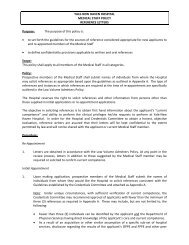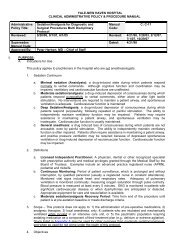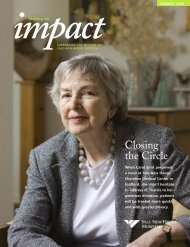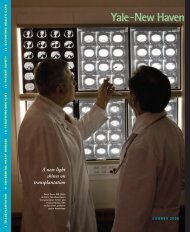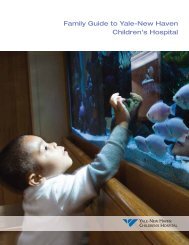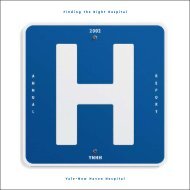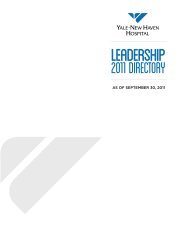Nursing Update 2007 - 2008 - Yale-New Haven Hospital
Nursing Update 2007 - 2008 - Yale-New Haven Hospital
Nursing Update 2007 - 2008 - Yale-New Haven Hospital
Create successful ePaper yourself
Turn your PDF publications into a flip-book with our unique Google optimized e-Paper software.
Hourly rounding boosts<br />
satisfaction all around<br />
Last summer, YNHH began hourly rounding by<br />
nurses and patient care associates on pediatric<br />
and medical units.<br />
Marcelle Applewhaite, R.N., patient service manager<br />
for the Infants/Toddlers Unit, and Francine<br />
LoRusso, R.N., director of nursing, Medicine,<br />
spearheaded the effort after a presentation last<br />
summer by a nationally known healthcare consulting<br />
company. The Studer Group had studied<br />
hourly rounding in 14 hospitals across the country,<br />
and found the protocol reduced monthly<br />
call button use by 38 percent, patient falls by 50<br />
percent and skin breakdowns by 14 percent. At<br />
the same time, satisfaction scores soared.<br />
Studer Group staff instructed YNHH nurses in<br />
eight key behaviors, including making an initial<br />
introduction to a patient with a description of<br />
role and experience, and documenting each<br />
visit so patients who are sleeping will know the<br />
caregiver has been in the room. Each hour, nurses<br />
also ask their patients about the four P’s: pain,<br />
positioning, placement and personal needs.<br />
Patient satisfaction scores rose at YNHH last<br />
year, and LoRusso and Applewhaite believe the<br />
new hourly rounding initiative contributed.<br />
In fact, early results of hourly rounding are so<br />
promising that the practice is being implemented<br />
hospital-wide this year.<br />
Rapid response teams<br />
keep patients out of ICUs<br />
When a nurse at YNHH notes a trigger sign in<br />
a patient such as a drop in blood pressure or<br />
simply has a hunch that a patient is deteriorating,<br />
she or he may call in a rapid response<br />
team—essentially an “ICU at the bedside.”<br />
The team will arrive in less than ten minutes<br />
to stabilize the patient.<br />
Rapid response teams were among six evidence-based<br />
safety interventions included in<br />
the Institute of Healthcare Improvement<br />
(IHI)’s campaign to prevent 100,000 in-hospital<br />
deaths. In 2004, IHI recognized <strong>Yale</strong>-<strong>New</strong> <strong>Haven</strong><br />
Children’s <strong>Hospital</strong> as one of the first pediatric<br />
hospitals in the country to implement a rapid<br />
response team made up of critical care nurses<br />
and physicians. Use of the teams at YNHCH<br />
resulted in a dramatic decrease in cardio-respiratory<br />
arrests outside of the pediatric ICU.<br />
Adult units at YNHH began using rapid response<br />
teams, which consist of critical care nurses,<br />
physicians and respiratory therapists, to provide<br />
urgent and emergent care in 2006.<br />
For both adults and children, the teams have<br />
been so successful in identifying early warning<br />
signs, avoiding the ICU and saving lives that the<br />
hospital is now planning pilot programs that will<br />
allow families who sense a loved one is deteriorating<br />
to activate the teams directly.<br />
Nurses dedicated to safety<br />
set new standards<br />
YNHH actively protects its patients from preventable<br />
danger through the work of two <strong>Yale</strong>-<strong>New</strong><br />
<strong>Haven</strong> Health System patient safety registered<br />
nurses—one for obstetrics, one for Perioperative<br />
Services.<br />
Working under the umbrella of Performance<br />
Management, the safety nurses’ primary role is to<br />
educate peers about safety, explains Jean Zimkus,<br />
patient safety nurse for Perioperative Services.<br />
They review literature on safety topics, talk to<br />
physicians and staff about unique challenges<br />
at YNHH, and spearhead improvements. They<br />
collaborate with other healthcare professionals<br />
to promote communication such as briefings and<br />
“hand-off communication,” essentially memos for<br />
new caregivers with pertinent information about<br />
patients who have been transferred from other<br />
units. They installed white boards in surgery suites<br />
for practitioners to make checklists about such<br />
concerns as allergies and fetal heart rates before an<br />
operation begins.<br />
A safety attitude questionnaire conducted among<br />
OB staff in 2004 and 2006, and in Perioperative<br />
Services in 2006 and <strong>2007</strong>, showed a statistically<br />
significant improvement in attitude toward safety<br />
and teamwork since their safety nurse was hired.<br />
Patient safety nurses expect to see continued<br />
improvement when they analyze the results of a<br />
<strong>2007</strong> survey in both their departments.<br />
Our soon to be hospital-wide hourly rounding<br />
initiative is a perfect example of something we<br />
often find when we seek out the evidence and<br />
take a hard look at how it fits with our needs<br />
at YNHH. Often a simple solution can bring<br />
greater rewards for less effort, and keep the<br />
focus where it matters most – on providing<br />
top-notch care for the patient.”<br />
— Francine LoRusso, R.N., Director of <strong>Nursing</strong>, Medicine<br />
Y A L E - N E W H A V E N H O S P I T A L 7



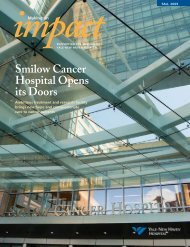
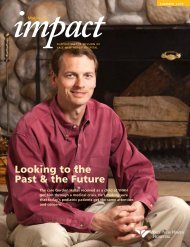

![Annual Report Donor Listings [pdf] - Yale-New Haven Hospital](https://img.yumpu.com/49673575/1/190x245/annual-report-donor-listings-pdf-yale-new-haven-hospital.jpg?quality=85)

